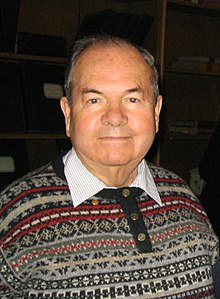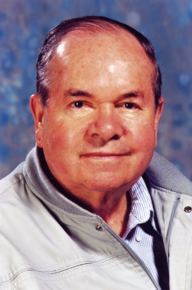Alexei Alexeyevich Abrikosov
Alexei Alexeyevich Abrikossow (Russian Алексей Алексеевич Абрикосов, scientific transliteration Alexei Abrikosov Alekseevic; born June 25, 1928 in Moscow, Soviet Union ) is a Russian physicist and Nobel laureate, whose major contributions are in the field of condensed matter.
Life
Abrikossow was born on 25 June 1928 in Moscow. He started after high school in 1943 a study of energy technology and moved in 1945 to physics. After graduating in 1948 he started his PhD thesis at the Institute for Physical Problems in Moscow, today Kapitza Institute, and received his doctorate in 1951 at Landau on thermal diffusion in complete and incomplete ionized plasmas. He remained at the Institute and in 1955 " Doctor of Science ", comparable to the habilitation, with studies on quantum electrodynamics at high energies. In 1965, he was charged with the management of the Department of Condensed Matter Theory at the newly founded Institute for Theoretical Physics, now the Landau Institute, entrusted. 1975 Abrikossow received an honorary doctorate from the University of Lausanne.
He took in 1991 an offer from the Argonne National Laboratory ( Illinois) and moved to the United States. In 1999 he took the U.S. citizenship, but remained connected to his Russian homeland. Abrikossow is a member of many prestigious institutions such as the National Academy of Sciences (USA ), the Russian Academy of Sciences, the Royal Society and the American Academy of Arts and Sciences.
In addition to his scientific work, he first taught until 1969 at the Moscow State University, and from 1970 to 1972 at the University of Gorky (now Nizhny Novgorod ). In the years 1972-1976 Abrikossow held the chair of theoretical physics at the Moscow Institute of Physics and Technology, in the years 1976-1991 a chair for selbiges specialist at the Moscow Institute of Steel and Alloys ( MISIS, now " State Technical University and research institution MISIS "). In the United States, he taught at the University of Illinois at Chicago and the University of Utah, in the UK, he taught at the University of Loughborough.
Abrikossow is married and has two sons and a daughter.
Work
Abrikossow discovered along with N.V. Zavaritskii, the experimental physicists of the Institute for Physical Problems, in reviewing the Ginzburg - Landau theory, a new class of superconductors, the " superconductors of the second kind ", which are now referred to as type - II superconductors. These new superconductors retain their superconducting properties, in contrast to the type I superconductors, even under the influence of strong magnetic fields (up to 25 Tesla). He could this behavior - based on the considerations of his Russian colleague Vitaly Ginzburg, who provided a theory for type - I superconductors - explained by the formation of a regular lattice of magnetic vortices, which are surrounded by ring currents. This arrangement is also called Abrikossow vortex lattice.
He also dealt with the transition to the metallic phase of hydrogen in hydrogen planet with quantum electrodynamics at high energies, on superconductivity in high-frequency fields and in the presence of magnetic impurities (where he discovered the possibility of superconductors without band gap), and was the Knight shift in zero temperature by considering the spin -orbit coupling explain. Another project dealt with the theory of non- superfluid ³ He and matter under high pressures, with semi-metals and the metal -insulator transition, the Kondo effect at low temperatures (where he predicted the Abrikossow - Suhl resonance ) and the construction of semiconductors no band gap; further investigations related one-dimensional or quasi - one-dimensional conductors and spin glasses.
Together with Lev Petrovich Gorkov and Igor Dsjaloschinski he wrote an internationally renowned book on field-theoretical diagram techniques in theoretical solid state physics (see below).
At Argonne National Laboratory he was able to explain most of the properties of high-temperature superconductors Kupratbasis and established a new effect had been, but never realized ( the " quantum linear magnetoresistance "), which measured in 1928 by Kapitsa first time as an independent effect in 1998.
He got together with Vitaly Ginzburg and Anthony James Leggett 2003 Nobel Prize in Physics " for pioneering contributions to the theory of superconductors and superfluids ".
Awards
- Member of the Academy of Sciences (now the Russian Academy of Sciences ), 1964
- Lenin Prize, 1966
- Fritz London Prize, 1972
- Honorary doctorate from the University of Lausanne, 1975
- State Prize of the USSR, 1982
- Full member of the Academy of Sciences (now the Russian Academy of Sciences ), 1987
- Landau Prize, 1989
- John Bardeen Award, 1991
- Nonresident honorary member of the American Academy of Arts and Sciences, 1991
- Member of the National Academy of Sciences, 2000
- Foreign member of the Royal Society, 2001
- Nobel Prize in Physics, 2003
Monographs
- Abrikosov, Gor'kov, Dzyaloshinskii: Quantum field theory methods in statistical physics. 1961 Dover reprint 1977, ISBN 0-486-63228-8
- AA Abrikossow, Introduction to the theory of normal metals. Vieweg, Braunschweig, 1976, ISBN 3-528-08382-4










